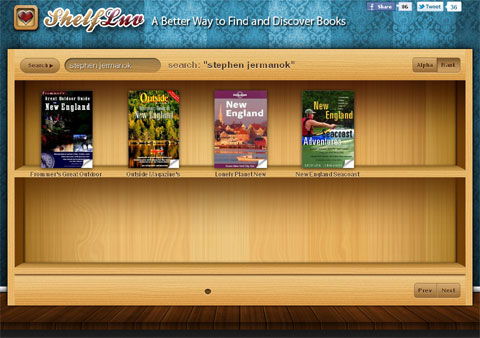A Next Frontier In Mobile Is Behind The Corporate Firewall
While I say I cannot predict the future, sometimes things are so glaring to some and not others, by pointing out you are opening eyes for some people. One of them for me is “a” next frontier in the use of mobile technology – to get beyond the corporate firewall and use all of the tools and data like you can do on a full computer. Note I say “a” next frontier, as it is out there, I just don’t know if it’s the “next” or “last” frontier.
Why do I believe this? Over the years I have managed public Web sites, corporate Intranets, Extranets, portals and knowledge management systems. I have seen how these tools, when used effectively, make people productive. I have also seen how when not managed properly they become a huge mess and waste of resources. Typically, there is a mix of these within most organizations, everything from advanced applications, to a PC under someone’s desk hosting a group’s Intranet Web site, to email.
Going Beyond Email
Using your mobile device to work as you would at work is long overdue. Most corporate workers who have a mobile device use it for email. But beyond email, there may be a limited amount of apps or data available to them. Mobile devices have Web browsers, but you may not be able to make a VPN connection within your company’s firewall. Not having this prevents you from accessing what you can do on your work computer, from your desk or away from it.
More and more email is being used to get around this lack of access. Have you ever asked co-workers or your admin to send you files or information you can’t get at? I see this all the time as friends – even my wife – have to do this in order to get what they may need for a conference call they have to make from a remote location. There’s no other way, especially if getting online with your notebook computer is not an option, or you don’t want to lug it (and power cables, etc.) around.
Going Beyond Mindsets and Existing Network Infrastructure
Shortly before his inauguration, there was buzz about how US President Obama wanted to carry a BlackBerry. In the end, he got one. It is not completely known what kind of security is in use with his device, but the bottom-line is it was achievable. My guess is it’s not out of reach for most companies.
Part of the issue with going mobile with your company information is a mindset it is not secure. This is where you need to go beyond your current infrastructure. As tablets and smarter phones hit the market and become more and more commonplace, the demands from staff will require both of these looming issues to be addressed.
Do I Need An App For That?
Once you go beyond the firewall, the fun begins. Some content and applications may already look great on a mobile browser. Some package applications may already have mobile-friendly interfaces, or even apps to access data. I recently saw a development tool for interfacing with CICS screens on an iPad. (If you don’t know what CICS is, its how most applications were developed on mainframe computers that allowed users to enter and query data. As many CICS screens are still alive and kicking today, thus the opportunity for such a tool). Then there’s the content and applications where you’ll need to either build or buy (or both) to access them outside of the office.
Access content and data in multiple formats on multiple platforms is an opportunity to drive innovation in your corporate Intranet and sites. Everything from comprehensive search to centralizing content to reaping value “dead” or unpopular content can be gained from this effort. As you go forward, build into your requirements mobile platform compatibility, whether for your own internal development or for your third-party vendors. Just think about taking an online training course on your mobile device while sitting in the waiting room for jury duty, and you get the power and convenience of extending the workplace to mobile devices.
Keeping Up With Small Businesses
Many small businesses have some of this capability already. Google Apps works well on Android devices. Salesforce.com has apps for many devices. QuickBooks Online has mobile versions of its full Web-based application. All of these are hosted, third-party services, which does not require the infrastructure to go beyond the firewall. As some larger businesses use Salesforce already, they have an advantage with the ability for their users to work on a mobile device.
Big Picture Thinking On Little Devices
Looking back on what I have presented, I covered a lot, and at a high-level, big picture perspective. As anyone who has worked in computer systems knows, the devil is in the details. But keeping in mind a roadmap to where you want to be, from the short-term to as far out as you can realistically plan, literally getting the information into the hands of those who need it will be critical and advantageous for any business. Let alone the opportunity for those who will be involved in making this happen, whether they build mobile hardware, platforms, apps or supporting software.
Do you agree on this future frontier of mobile? Are you looking forward to it? Are you using it today? Please share your thoughts in the comments of this post.
Did you enjoy reading this? You are welcome to subscribe to The Hot Iron by RSS feed or by email.
Next likemind Chicago on Friday February 18
 The next likemind will be Friday, February 18, 2011 in dozens of cities around the world.
The next likemind will be Friday, February 18, 2011 in dozens of cities around the world.
In Chicago, it will be at Argo Tea, 140 S Dearborn St. at the corner of Adams and Dearborn Streets in the Loop from 8:00 am to 10:00 am.
I call likemind a gathering of creative-minded people, from various disciplines including Internet, advertising, art, social media, et. al. For more on likemind, read this great article on likemind Chicago from the Newcity and likemind from the New York Times.
Follow @likemindchicago on Twitter.
Watch for future date announcements at http://likemindchicago.com/ - and Web site coming soon at that address!
Did you enjoy reading this? You are welcome to subscribe to The Hot Iron by RSS feed or by email.
Happy 2011 And The Hot Iron At 4
Happy 2011! Rather than type I decided to record a video greeting for the new year, plus look back on 4 years of this very blog, The Hot Iron.
If you don’t see the video above, follow this link to view it on YouTube.
Did you enjoy reading this? You are welcome to subscribe to The Hot Iron by RSS feed or by email.
Next likemind Chicago on Friday December 3
 The next likemind will be Friday, December 3, 2010 in dozens of cities around the world.
The next likemind will be Friday, December 3, 2010 in dozens of cities around the world.
Note this is not the usual 3rd Friday of the month, as there is a combined November/December likemind each year due to the holidays.
In Chicago, it will be at Argo Tea, 140 S Dearborn St. at the corner of Adams and Dearborn Streets in the Loop from 8:00 am to 10:00 am.
I call likemind a gathering of creative-minded people, from various disciplines including Internet, advertising, art, social media, et. al. For more on likemind, read this great article on likemind Chicago from the Newcity and likemind from the New York Times. Follow @likemindchicago on Twitter.
Did you enjoy reading this? You are welcome to subscribe to The Hot Iron by RSS feed or by email.
ShelfLuv Makes Book Shopping Fun
Recently Google changed their search results page to incorporate something called Google Instant, whereby as you type the search results on the page change. This type of “instant” technology has been met with mixed opinions, where some love it and others hate it, and I am in the latter camp. This “instant” idea was recently applied to Amazon.com book searches, and I have to admit I do love ShelfLuv.
ShelfLuv is the brainchild Pek Pongpaet, a Chicago user experience designer and developer, among other hats he wears. For the sake of full disclosure, I know Pek. One of the benefits of knowing him is seeing the ideas he makes into reality, and one of them is ShelfLuv. Rather than just refreshing a page with book suggestions, he created the visual of a bookshelf to show the book suggestions based on the keyword or keywords you enter. As the words change, so do the books on the shelf. And when you click on a book, you can see a brief description, review and excerpt if available. You also have the option to view similar books.
Below is a screenshot of ShelfLuv where it displays 4 books written by one of my clients, Steve Jermanok who blogs at ActiveTravels.

ShelfLuv is definitely something you want to experiment with for yourself. For example, I typed in 3 words, one at a time – new, England and Patriots. With each word, the selection changed from new releases to knitting books to books on my favorite football team. It is not only a unique way to shop for books, but a great example of how a great presentation layer on top of technology can make all the difference in the success of any Web site or service.
Did you enjoy reading this? You are welcome to subscribe to The Hot Iron by RSS feed or by email.

